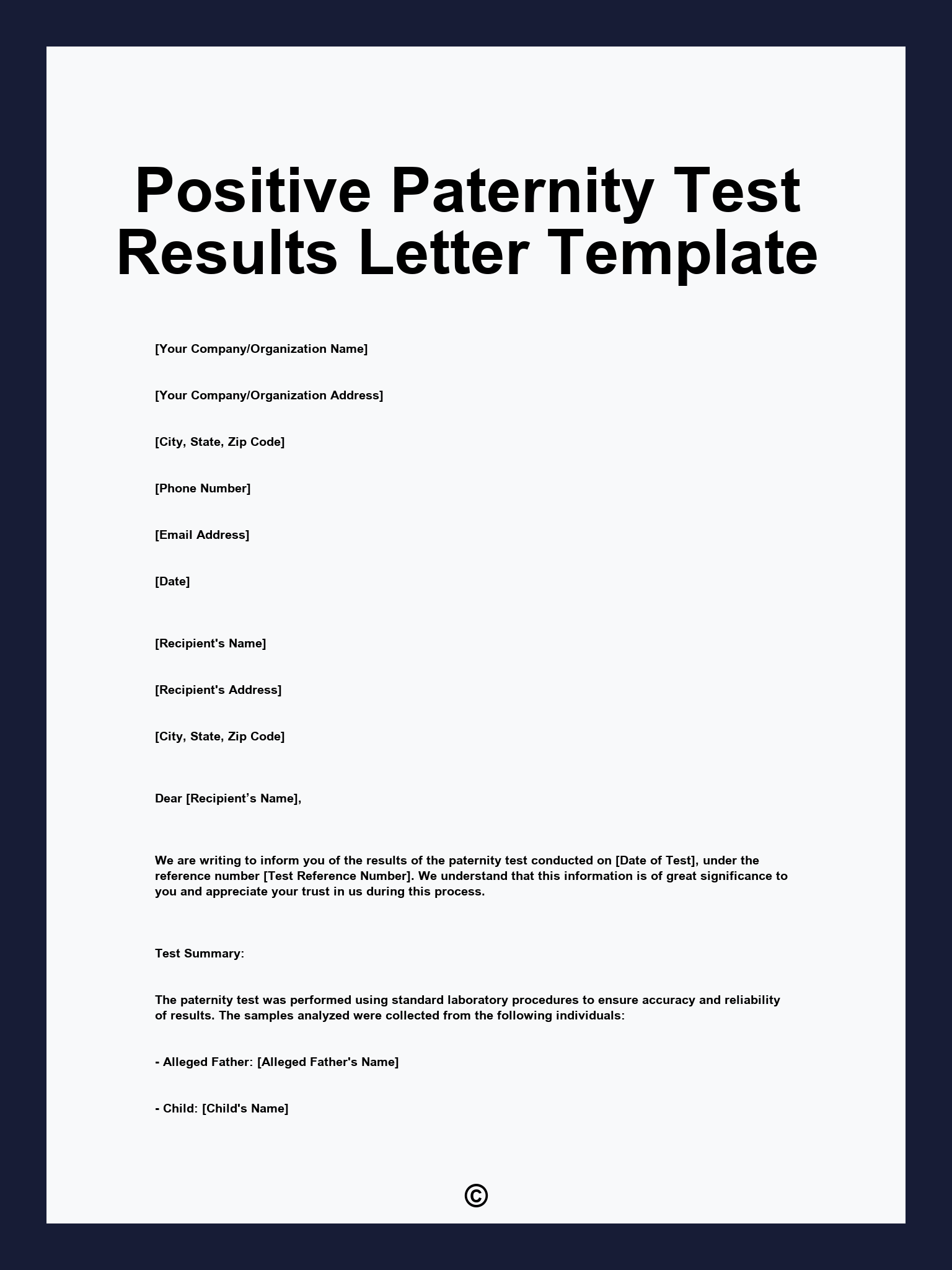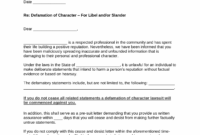Receiving the results of a paternity test can be a moment filled with a whirlwind of emotions, whether it’s relief, joy, or perhaps a touch of apprehension about what comes next. Once the lab confirms a biological connection, the next crucial step often involves communicating these significant findings to the presumed father. This isn’t just about sharing a piece of paper; it’s about initiating a life-altering conversation that requires sensitivity, clarity, and a forward-thinking approach.
You might be wondering how to best convey such monumental news in a way that is both clear and respectful. That’s where having a well-structured communication tool becomes incredibly valuable. This article is designed to guide you through the process, offering insights and a practical framework for drafting a positive paternity test results letter template. We understand the weight of this moment, and our goal is to help you navigate it with confidence and compassion.
Crafting Your Letter: Essential Elements for Clear Communication
Once you have the definitive results in hand, composing a letter to the presumed father isn’t just a formality; it’s a vital first step in establishing a clear line of communication and setting the tone for future interactions. This letter serves multiple purposes: it formally informs him of the biological relationship, provides evidence, and opens the door for discussing the child’s future. It’s important to approach this with a blend of factual information and empathy, recognizing the profound impact this news will have.
Think of this letter as a bridge. It connects the scientific confirmation with the personal reality, helping both parties understand the new landscape. It’s not just about stating “you are the father”; it’s about providing context, demonstrating the seriousness of the situation, and inviting a constructive dialogue. A well-written letter can prevent misunderstandings and provide a solid foundation for subsequent conversations, whether they involve co-parenting discussions or legal considerations.
The goal is to be unequivocal, leaving no room for doubt about the outcome of the test, while also maintaining a tone that encourages engagement rather than defensiveness. This means carefully selecting your words and ensuring all necessary details are included. Remember, this document may also serve as a reference point in any future legal proceedings, so accuracy and completeness are paramount. Crafting a thoughtful positive paternity test results letter template is a critical step in a potentially life-changing process, so take your time and ensure every detail is considered.

Before you begin writing, gather all relevant documents, including the official paternity test results from the accredited laboratory. Having these at hand will ensure accuracy and allow you to easily reference specific details. Consider the emotional weight of this communication for the recipient, and aim for a tone that is firm yet understanding. The goal is to inform and open a dialogue, not to accuse or confront.
Key Sections to Include in Your Letter
When drafting your positive paternity test results letter template, focus on these core components to ensure it’s comprehensive and effective:
- Your Information and the Child’s Information: Clearly state your full name and the full name and date of birth of the child involved. This ensures there’s no ambiguity about who the letter pertains to.
- Date of Letter and Test Results: Include the date the letter is being written and specify the date the paternity test was conducted and when the results were received.
- Clear Statement of Results: Directly and unambiguously state the positive outcome of the paternity test. For example, “The paternity test results confirm that you are the biological father of [Child’s Name].”
- Supporting Documentation: Mention that a copy of the official paternity test results from the accredited laboratory is enclosed with the letter. This provides undeniable proof.
- Next Steps and Invitation for Discussion: Suggest a desire to discuss the implications of these results, such as child support, custody arrangements, and visitation. Provide a way for the recipient to contact you to arrange a meeting or further conversation.
- Contact Information: Reiterate your contact details, including phone number and email, so the recipient can easily reach out.
- Consideration of Legal Advice: You might also include a brief statement encouraging both parties to seek independent legal counsel to understand their rights and responsibilities.
Navigating the Conversation and Future Steps After Sending the Letter
Sending a positive paternity test results letter template is a significant step, but it’s often just the beginning of a longer journey. The way you handle the subsequent conversations and actions can profoundly influence the co-parenting relationship and the child’s future well-being. It’s crucial to prepare yourself for a range of potential reactions, from acceptance and a desire to be involved, to shock, denial, or even anger. Maintaining a calm, composed, and child-focused approach throughout this process will be immensely beneficial.
After the letter has been delivered, it’s wise to give the recipient some time to process the information. This news can be overwhelming, and expecting an immediate, perfectly composed response might be unrealistic. When the time comes for a discussion, try to choose a neutral, private setting where both parties can speak openly and without interruption. Focus on the child’s best interests as the guiding principle for all discussions about future arrangements, including financial support, visitation, and decision-making responsibilities.
Remember that this isn’t solely about your feelings or the presumed father’s feelings; it’s ultimately about establishing a stable and supportive environment for the child. While emotions may run high, try to steer the conversation towards practical solutions and a collaborative spirit. If discussions become contentious or difficult, don’t hesitate to suggest mediation or seek professional guidance to help facilitate constructive dialogue. Legal professionals specializing in family law can also offer invaluable advice on rights and obligations.
Beyond the immediate discussions, there are several practical considerations to keep in mind. These range from updating official documents to ensuring the child’s legal and financial needs are met. This often involves navigating the legal system, which can seem daunting. However, understanding the typical next steps can empower you to proceed confidently and ensure the child’s rights are protected.
- Consider seeking legal advice immediately after sending the letter. A family law attorney can explain your rights and the father’s responsibilities, as well as guide you through potential child support and custody proceedings.
- Be prepared for varying responses. Some fathers may embrace their new role, while others may require more time or even initial resistance. Patience and a willingness to communicate openly are key.
- Prioritize the child’s well-being in all discussions. All decisions should ultimately serve their best interests, focusing on stability, financial support, and emotional well-being.
- Keep clear records of all communications, including the sent letter, any responses, and notes from meetings or phone calls. This documentation can be vital if legal action becomes necessary.
- Explore resources for co-parenting. There are many organizations and online tools that offer guidance and support for parents navigating new co-parenting relationships.
Navigating the aftermath of a positive paternity test is undoubtedly a complex journey, one that demands both emotional fortitude and practical planning. By utilizing a clear and comprehensive letter, you lay a solid groundwork for transparent communication and establish the seriousness of the situation from the outset. This initial step, while challenging, is fundamental in ensuring that the child’s needs and future are appropriately addressed.
Remember that you don’t have to face these new developments alone. There are resources, legal professionals, and support networks available to assist you in every step, from formalizing agreements to fostering a healthy co-parenting relationship. Your proactive approach in communicating these results thoughtfully is a testament to your commitment to the child’s best interests, setting the stage for a future where their well-being remains the central focus.



